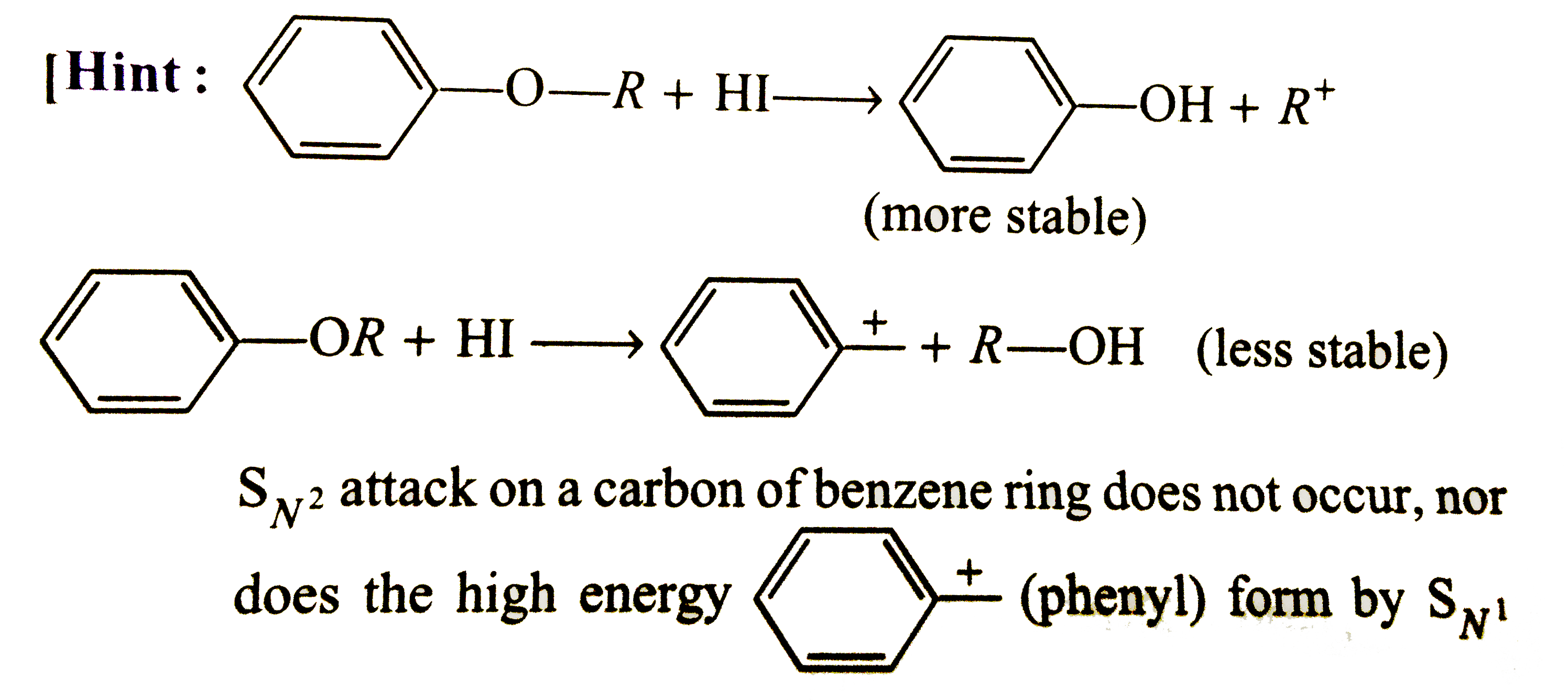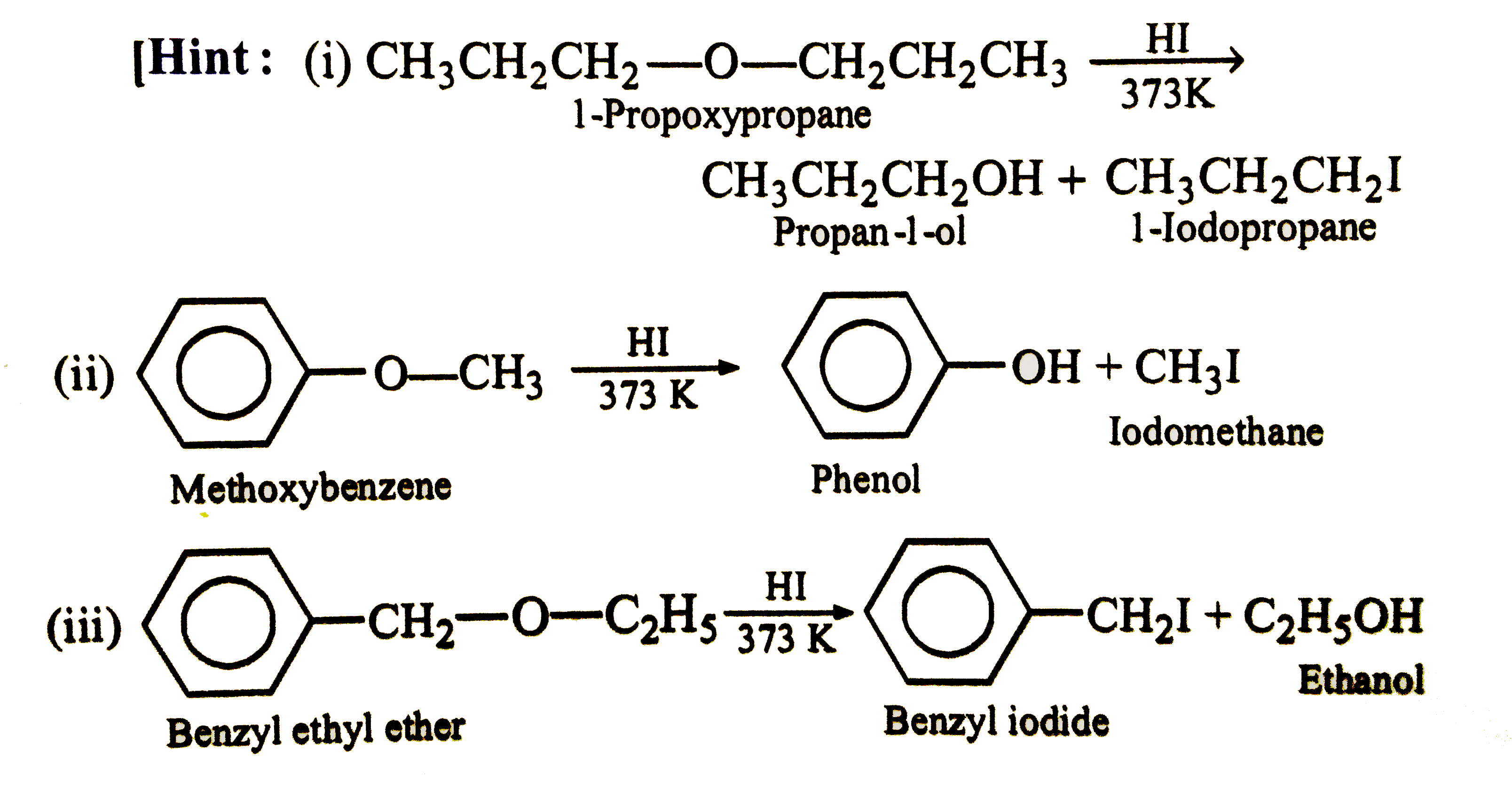Account for the following
(i) Ethers have significant dipole moments.
(ii) Ethers have lower boiling points than the corresponding isomeric alcohols but approximately equal to a paraffin with similar molecular mass structure.
(iii) HI is better reagent than HBr for cleavage of ethers.
(iv) Why a non-symmetrical ether is not prepared by heating a mixture of ROH and R'OH in acid ?
(v) Why is it possible to prepare tertiary butyl ethyl ether in good yield by heating tertiar butanol and ethanol ?
(vi) Ether are soluble in conc. but ethers separate out from the solution on addition of water.
(vii) Why id diethyl ether used as a solvent for (i) and (ii) RMgBr ?
(viii) Sometimes explosion occrs during distillation of an ether sample.
(ix) Why cannot be prepared either by Williamson's reaction or by dehydration of tertiary butyalcohol ?
(x) Why ArO-R ethers are clearved with HI to give RI and ArOH rather than ArI and R-OH ?
(xi) Which of the following is the correct method for synthesising methyl tert-butyl ether and why ?
(a)
(xii) 2,2-Dimethyl oxirane can be cleaved by acid . Write mechanism.
(xiii) Write the equations of the reaction of hydrogen iodide with
(i) 1-Propoxypropane (ii) Methyoxybenzene
9iii) Benzyl ethyl ether
Text Solution
(i) Ethers are weakly polar. The C-O-C bond angle is about 383K and the C-O moments do not cancel each other .
(ii) ROH molecules have strong intermolecular attractive forces because of hydrogen bonding that is absent in ethers having two polarity. Hence, the boiling points of ethers are low.
(iii) HI is a stronger acid than HBr and thus, oxonium salt is readily formed with greater yields. is also a better nucleophile than in reaction.
(iv) A mixture of three ethers, and is obtained.
(v) When one alcohol is , the oxonoium ion easily loses water to form carbocation, whichis solvated by or alcohol to form mixed ether.
.
(vi) Water is a stronger base than ether and removes the proton from
(viii) Ethers form peroxide with oxygen. The boiling point of peroxide is higher than that of ether . It is, thus, left as residue in the distillation of ether which is very unstable and decomposes violently on heating .
(ix) The product in both the cases is isoubutylene as the tert-butyl carbocation elemination an . The reaction between on to give an ether is sterically hindered.
The instability of di-, tert-butyl ether in sulhuric acid may also be due to steric crowding of groups ?

(xi) The ether formation involves nucleophilic substitution of alkoxide ion for halide ion.

alkyl halide can also involve elimination of HX to give alkene in the presence of a base. So, it is better to start with alkoxide and alkyl halide, i.e., equation (b).
(xii) The oxirane ring is cleaved via mechanism.


|
Topper's Solved these Questions
- ALCOHOLS, PHENOLS AND ETHERSBook:OP TANDONChapter:ALCOHOLS, PHENOLS AND ETHERSExercise:PROBLEMS BASED ON STRUCTURE AND PROPERTIES
Explore 7 Videos
- ALCOHOLS, PHENOLS AND ETHERSBook:OP TANDONChapter:ALCOHOLS, PHENOLS AND ETHERSExercise:BRAI STORMING PROBLEMS
Explore 32 Videos
- ALCOHOLS, PHENOLS AND ETHERSBook:OP TANDONChapter:ALCOHOLS, PHENOLS AND ETHERSExercise:PHENOLS
Explore 91 Videos
- ALDEHYDES AND KETONES Book:OP TANDONChapter:ALDEHYDES AND KETONES Exercise:SINGLE INTEGER ANSWER TYPE QUESTIONS
Explore 10 Videos
Similar Questions
Knowledge Check
Ethers have lower boiling points that their correseponding isomeric alcohols because of
Ahydrogen bonding in alcohols that is absent in ethers due to lwo polarityBhydrogen bonding in ethers due to high polartiyCinsolubility of ethers in water due to less polarityDinertness of ethers as compared to alcohos .Ethers have lower boiling points that their correseponding isomeric alcohols because of
Ahydrogen bonding in alcohols that is absent in ethers due to lwo polarityBhydrogen bonding in ethers due to high polartiyCinsolubility of ethers in water due to less polarityDinertness of ethers as compared to alcohos .Ether have a net dipole moment because
AC-O bonds in ethers are non-polarBC-O bonds in ethers are polarCC-C bonds in ethers are polarDC-C bonds in ethers are non-polar
Explain why ArOR ethers are cleaved to give RI and ArOH rather
than Arl and ROH.
View SolutionExplain why ArOR ethers are cleaved to give RI and ArOH rather than Arl and ROH.
View Solution(a) Explain why a nonsymmetrical ether is not usually prepared by heating a mixture of ROH and R'OH in acid.
(b) Why is it possible to prepare t-butyl ethyl ether by heating a mixture of t-butanol and ethanol?
(c ) Would you get any di-t-butyl ether from this reaction? Explain.
(d) Can t-butyl ethyl ether be made by heating H2C=CH(CH3)2 and ethanol?
View SolutionEthers have less dipole moments than alcohols. Justify.
View SolutionDipole moment of diiethyl ether is lower than that of
View Solution

